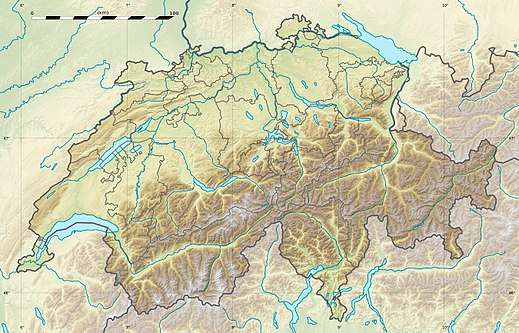Hölloch
The Hölloch (English: Hellhole)[2] is a 200.4 km (124.5 mi) long cave in the municipality Muotathal in Switzerland. In addition to being the second longest cave in Europe, it is also notable for having a depth of 938.6 m (3,079 ft).[1] The Hölloch is an example of a karst cave system. [3]
| Hölloch | |
|---|---|
 Hölloch Location in Switzerland | |
| Location | Canton of Schwyz, Switzerland |
| Coordinates | 46°58′35.9″N 8°47′18.2″E |
| Depth | 938.6 m (3,079 ft)[1] |
| Length | 200.421 km (124.536 mi)[1] |
| Discovery | 1875 |
| Geology | Limestone |
| Show cave opened | 1906 |
Exploration
The cave was first scientifically explored in 1875 by a group led by Alois Ulrich.[2] Later expeditions in the 1950s by Alfred Bögli, one of the pioneers of speleology, managed to explore a large part of the cave.[2]
The explored length of the cave increased from 25 km (16 mi) in 1952 to 100 km (62 mi) by 1968. It was the first cave in the world where the explored length reached 100 km, and until the linkage of the Flint Ridge Cave System to the Mammoth Cave System in 1972, it was believed to be the largest cave system in the world.[2][1]
Despite this, exploration of the Hölloch continued, and in 1976 it had been mapped to approximately 130 km (81 mi) long.[2]
Tourism
A portion of the cave near the entrance is open to visitors, but the remainder is restricted to qualified spelunkers owing to its enormous size.[2]
References
- Bob Gulden (May 13, 2013). "Worlds longest caves". Geo2 Committee on Long and Deep Caves. National Speleological Society (NSS). Retrieved June 12, 2013.
- Scheffel, Richard L.; Wernet, Susan J., eds. (1980). Natural Wonders of the World. United States of America: Reader's Digest Association, Inc. p. 183. ISBN 0-89577-087-3.
- Ford, D.C.; Ewers, R.O. (1978-06-19). "The development of limestone cave systems in the dimensions of length and depth". Department of Geography, McMaster University, Hamilton, Onf., Canada L8S 4KI. Canadian Journal of Earth Sciences. 15 (11): 1783–1798.
- Courbon, Paul; Peter Bosted; Claude Chabert; Karen Lindsley (1989). Atlas of the Great Caves of the World. St. Louis, Missouri: Cave Books.
External links
| Wikimedia Commons has media related to Hölloch Cave. |